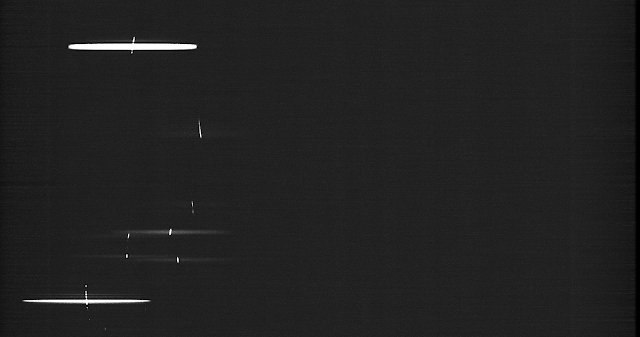 |
| Range-Velocity-Acceleration matched filterbank output for the Svalbard Radar. The colors scale ranges from SNR=0 to 100. The x-axis is range (100 to 3000 km), and the y-axis is time (0 to 200 seconds). The coherent integration length is ten 1.92 ms transmit pulses, with 20 ms inter-pulse periods. How many space debris objects can you see? I can see about 9. This to indicate that my new analysis is working quite well, as this would result in about 160 detections per hour. |
I've been writing some code to do Range-Velocity-Acceleration matched filtering of moving space objects from Arecibo radar data. The processing is heavier than the usual EISCAT beampark analysis. The Arecibo coded long pulse requires analysis with 150 meter range resolution. I estimate that I will need to use 300 CPU hours to analyze one hour of actual data. This is why I've parallelized the code with MPI, so I can run it on the Stallo cluster. Most of the code runs on Python (mpi4py), but I had to implement the critical part using a little snippet of C. I've already managed to successfully submit a test job, but I'm doing a few more tweaks before I kick off the big run.
The code seems to be working, but I want to make sure that everything works right. I'm therefore reanalyzing Svalbard (32 m dish, 500 MHz frequency) data, and comparing the results with Jussi Markkanen's analysis. Here's a plot from the Svalbard re-analysis. This particular 200 second time window caught quite a few detections. The hourly rate would be 300 debris detections per hour!




Avoid surprises — interviews need preparation. Some questions come up time and time again — usually about you, your experience and the job itself.thanks a lot.
ReplyDeleteC and C++ Training Institute in chennai | C and C++ Training Institute in anna nagar | C and C++ Training Institute in omr | C and C++ Training Institute in porur | C and C++ Training Institute in tambaram | C and C++ Training Institute in velachery
it is really wonderful and awesome thus it is very much useful for me to understand many concepts and helped me a lot. it is really explainable very well and i got more information from your blog.
ReplyDeletepython training in chennai
python course in chennai
python online training in chennai
python training in bangalore
python training in hyderabad
python online training
python training
python flask training
python flask online training
python training in coimbatore
Smm panel
ReplyDeleteSmm panel
iş ilanları
İNSTAGRAM TAKİPÇİ SATIN AL
hirdavatciburada.com
Www.beyazesyateknikservisi.com.tr
SERVİS
tiktok jeton hilesi
Your gain ground is genuinely loved constant and the globe. it's miles indisputably an aggregate and supportive blog. iCare Data Recovery With Crack
ReplyDelete